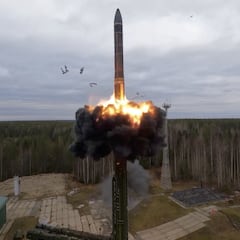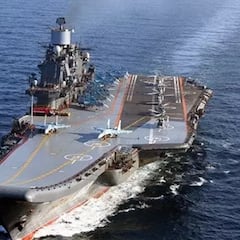This is 'Poseidon', the Russian nuclear “doomsday” torpedo that is "unstoppable"
Poseidon is one of six Russian experimental “super weapons” capable of evading current defense systems through its underwater drone system.

Russia’s Poseidon, also known by its NATO designation Kanyon and formerly referred to as Status-6, is a nuclear torpedo that has redefined the concept of strategic weaponry. Developed by the Rubin Maritime Design Bureau, this torpedo represents a new generation of underwater weapon systems, combining unparalleled evasion capabilities with immense destructive potential.
A torpedo with unlimited range
Poseidon is powered by a nuclear reactor, granting it a virtually unlimited range. Its first known test launch occurred on November 27, 2016, from the specially outfitted B-90 Sarov submarine in the Arctic Ocean, according to the Pentagon. This weapon can dive to depths of up to 3,280 feet (1,000 meters) and travel at astonishing speeds of up to 100 knots (115 mph). Weighing over 90 tons, it measures almost 60 feet (over 18 meters) in length and has a diameter of 6.5 feet (2 meters), making it the largest torpedo ever developed.
But its impressive size isn’t the only standout feature—Poseidon’s speed and stealth capabilities along with its possible nuclear payload make it a particularly concerning addition to Russia’s arsenal.
Dual-purpose warhead for maximum impact
Poseidon is designed to carry either conventional or nuclear warheads, with a maximum yield of up to two megatons. Its devastating potential makes it capable of targeting coastal cities or naval groups, such as aircraft carrier strike formations. In certain scenarios, the weapon could even trigger “radioactive tsunamis” to wreak havoc on designated areas, although this ability is questionable, underscoring its role as a tool for widespread devastation.
Nuclear propulsion: revolutionary yet risky
Poseidon’s use of nuclear propulsion is a significant technological leap—one that the United States had briefly explored in the 1960s but abandoned. However, this advancement comes with risks. If the propulsion systems lack sufficient shielding or containment, they could release radioactive materials, potentially creating unintended environmental hazards.
Putin’s statement and recent developments
Russian President Vladimir Putin confirmed on February 2, 2019, that Poseidon had completed a crucial stage of testing. By the end of that month, Russia’s Ministry of Defense released video footage showing a Poseidon test launch from the B-90 Sarov submarine. This demonstration highlighted its readiness for deployment as one of Russia’s most advanced and experimental weapons.
Part of Russia’s Experimental Super-Weapons Arsenal
Poseidon is just one of six cutting-edge “super weapons” that Russia has unveiled in recent years. Others in this elite group include the Sarmat intercontinental ballistic missile, the Avangard hypersonic glide vehicle, the Burevestnik nuclear-powered cruise missile, the Kinzhal ballistic missile, and the Zircon anti-ship hypersonic missile.
Related stories
Original article written by Laura Martin Sanjuan, translated with the assistance of AI and edited by Greg Heilman.
Get your game on! Whether you’re into NFL touchdowns, NBA buzzer-beaters, world-class soccer goals, or MLB home runs, our app has it all. Dive into live coverage, expert insights, breaking news, exclusive videos, and more – plus, stay updated on the latest in current affairs and entertainment. Download now for all-access coverage, right at your fingertips – anytime, anywhere.

